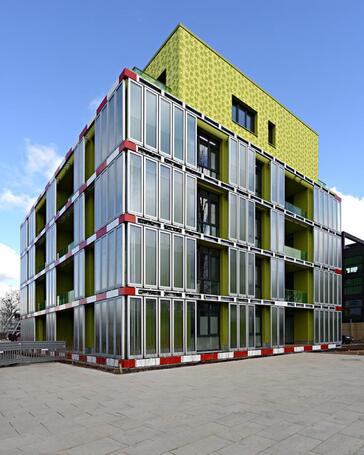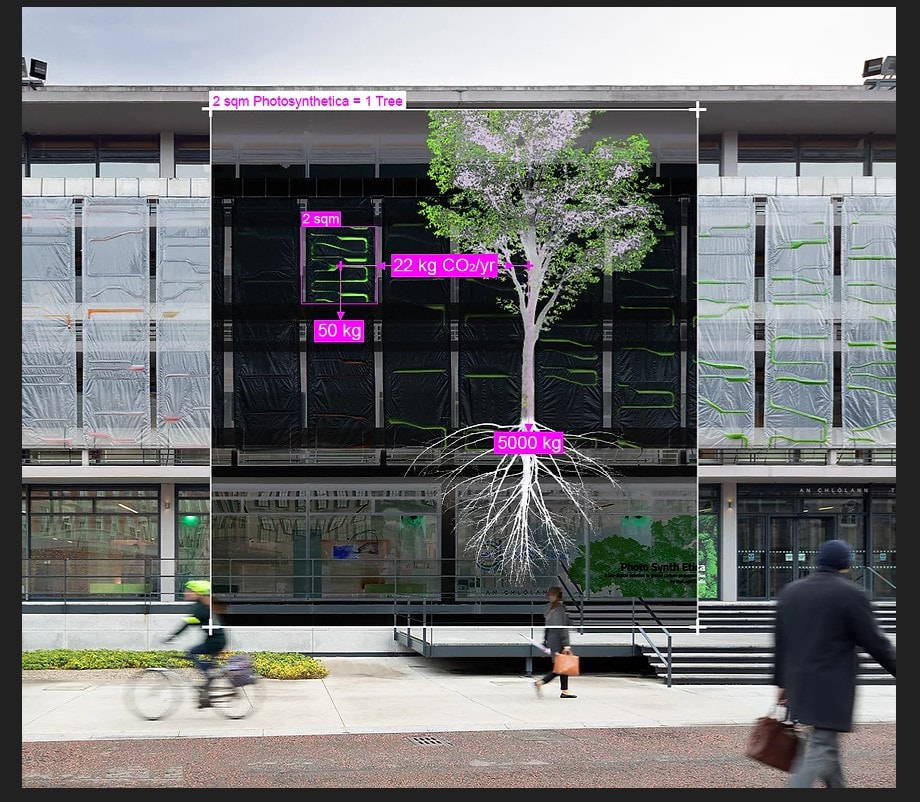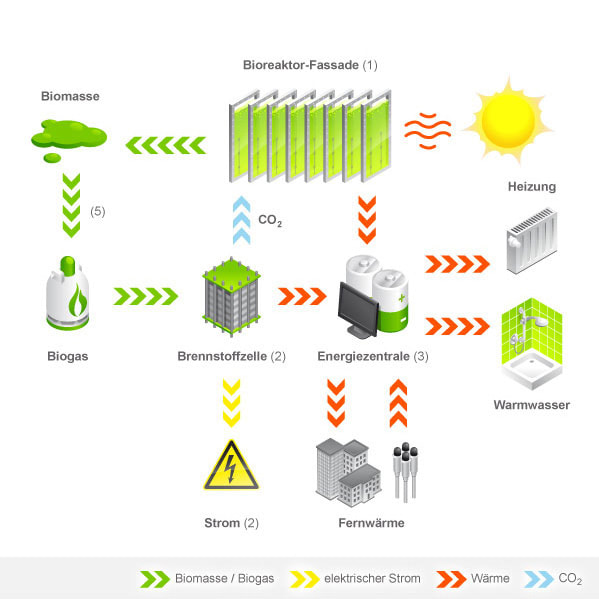Background
The past year has been one of the hardest that the world as a whole have seen, the Covid-19 pandemic sent people indoors and opened up a current concern within our built environment. Usually, when talking about the air quality people will automatically think about the outdoors. The urban city covered in smog, full of cars and bustling people. However, there is another air quality that is of concern, the indoor air. Current code standards set up by ASHRAE specifies the rate of change an air space needs during the design and construction phase of a project. In an effort to increase the efficiency of buildings we have tightened our air infiltration and confined ourselves within a space that is not always healthy. In some studies, the EPA has found that there can be 2 to 5 times more air pollutant particles inside than outdoors and in some cases as high as 100 times.
 SolarLeaf | Algae bio-reactive facade
SolarLeaf | Algae bio-reactive facade
In an effort to combat such pollutants some designers have taken a new approach to façade systems incorporating bio facades as a means of helping with the air problems, and still maintaining the concern for the efficiency within the building. SolarLeaf is a building project in Hamburg during 2013. It is the first bio-reactive façade to use algae as a shading device and a form of renewable energy and solar thermal heat. The closed system uses the heat from the water solution the algae grows in for temperature control. In addition to this the algae biomass is harvested and used to produce energy. This closes the loop allowing the CO2 burned during the process to be filtered back into the algae system.
Algae is an effective system because of its CO2 sequestering rate. It is a natural product that only needs CO2 and sunlight to grow and become effective. In other studies with this technology a company called photo.Synthetica is looking at the use and expansion of different types of algae. Their main projects are currently temporary, but they have explored illumine cent algae in their studies and have also found that 2sqm of their growth system is equivalent to the CO2 captured by a single full adult tree. Both reduce 22kg of CO2/yr, but within the city environment it makes it difficult to have large quantities of trees, where several buildings with this cladding system would be much more effective.
With such systems in development there are other concerns that need to be addressed. One of the major ones is the environmental factors should there be a leak. Algae has been for creating blooms within areas that are rich in phosphorus and nitrogen. Run-off from agriculture and manicured lawns can add these chemicals into the water supply creating high areas of density helping to contribute to blooms that are not common. Not all algae is safe, when a bloom occurs it can be deadly to the sea-life that lives below the bloom creating a dead zone. Florida is well known for having such a harmful alga bloom even calling it the “Red Tide”. The algae used in the façade systems are different than that found in the red tide, but it can still be harmful if not treated properly.
The main cause for concern when an algae bloom occurs is the Oxygen levels and the light levels. When the algae are growing there isn’t any issues but once it dies and starts to turn brown all of the CO2 that it had contained until that point gets released into the water causing a Oxygen depleted zone. In addition to that the bloom is also very dense, so it blocks the sunlight from entering the waters below. This blockage of sun is what makes it a great shading device, but if it complete blocks the sun when fully grown it will defeat its purpose of being used in a façade system. That is why further testing will need to be done on the available light a fully grown system will let in.
The main cause for concern when an algae bloom occurs is the Oxygen levels and the light levels. When the algae are growing there isn’t any issues but once it dies and starts to turn brown all of the CO2 that it had contained until that point gets released into the water causing a Oxygen depleted zone. In addition to that the bloom is also very dense, so it blocks the sunlight from entering the waters below. This blockage of sun is what makes it a great shading device, but if it complete blocks the sun when fully grown it will defeat its purpose of being used in a façade system. That is why further testing will need to be done on the available light a fully grown system will let in.
Sources
More Than Green. “SolarLeaf | Algae Bio-Reactive Facade,” September 3, 2014. http://www.morethangreen.es/en/solarleaf-solar-leaf-algae-bio-reactive-facade/.
photoSynthetica. “SYSTEM.” Accessed March 30, 2021. https://www.photosynthetica.co.uk/system.
US Department of Commerce, National Oceanic and Atmospheric Administration. “Gulf of Mexico: Harmful Algal Blooms.” Accessed March 30, 2021. https://oceanservice.noaa.gov/hazards/hab/gulf-mexico.html.
US EPA, OAR. “Introduction to Indoor Air Quality.” Collections and Lists. US EPA, August 14, 2014. https://www.epa.gov/indoor-air-quality-iaq/introduction-indoor-air-quality.
———. “Why Indoor Air Quality Is Important to Schools.” Overviews and Factsheets. US EPA, October 27, 2015. https://www.epa.gov/iaq-schools/why-indoor-air-quality-important-schools.
US EPA, OW. “The Effects: Dead Zones and Harmful Algal Blooms.” Overviews and Factsheets. US EPA, March 12, 2013. https://www.epa.gov/nutrientpollution/effects-dead-zones-and-harmful-algal-blooms.
photoSynthetica. “SYSTEM.” Accessed March 30, 2021. https://www.photosynthetica.co.uk/system.
US Department of Commerce, National Oceanic and Atmospheric Administration. “Gulf of Mexico: Harmful Algal Blooms.” Accessed March 30, 2021. https://oceanservice.noaa.gov/hazards/hab/gulf-mexico.html.
US EPA, OAR. “Introduction to Indoor Air Quality.” Collections and Lists. US EPA, August 14, 2014. https://www.epa.gov/indoor-air-quality-iaq/introduction-indoor-air-quality.
———. “Why Indoor Air Quality Is Important to Schools.” Overviews and Factsheets. US EPA, October 27, 2015. https://www.epa.gov/iaq-schools/why-indoor-air-quality-important-schools.
US EPA, OW. “The Effects: Dead Zones and Harmful Algal Blooms.” Overviews and Factsheets. US EPA, March 12, 2013. https://www.epa.gov/nutrientpollution/effects-dead-zones-and-harmful-algal-blooms.

